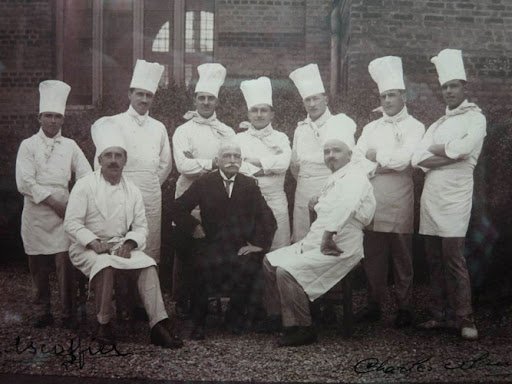Boys.
“It is simply that man is more thorough in his work, and thoroughness is at the root of all good, as of everything else.”
Chef Georges Auguste Escoffier.

History.
The first renowned culinary authorities—celebrity chefs, if you will—were French men.
Marie Antoine Carême and Georges Auguste Escoffier were the earliest figures to unify and elevate professional cooking by separating it from the feminine work of home cooking (Harris & Giuffre).
Marie Antoine Carême (1784-1833), known as the “King of Chefs,” played a tremendous role in the professionalization of cooking. He had an illustrious career cooking lavish feasts for French nobility which earned him a reputation as an artist, rather than a manual laborer (Harris & Giuffre). He designed the white coats and toques that chefs still wear today to signal their professional status, and he wrote a three-volume cookbook that further established chefs as experts far removed from “la petite cuisine” done by women at home (Harris & Giuffre).
Georges Auguste Escoffier (1846-1935) was in many ways his successor. Escoffier followed Carême and was coming to prominence during industrialization, when the ideology of separate spheres was created and cemented. Industrialization in Europe and the United States provided new job opportunities for men, who went to work outside the home while women became primary homemakers and caretakers. This cultural shift, in tandem with Escoffier’s continued efforts to legitimize cooking as a profession, further masculinized the field.
While working at The Savoy Hotel in London, Escoffier introduced the brigade system: the extremely hierarchical organization of kitchen work still used in most restaurants today. (It even makes an appearance in the opening scene of Spencer, the most recent Diana biopic.) He had worked as an army chef and borrowed this system from the military—another highly masculinized profession—with an emphasis on efficiency and standardization (Harris & Giuffre). These militaristic origins have permitted masculinized values to dominate in restaurants (Albors-Garrigos). Escoffier was also a prolific and impactful cookbook writer: Le Guide Culinaire is still used in kitchens around the world. His body of published texts continued Carême’s work of establishing cooking as an elite profession that required specific knowledge and training.
Exclusion of Women.
By the early twentieth century, professional cooking was populated by men.
As the field gained prestige, women found themselves explicitly excluded. They were banned from culinary trade unions and competitions—both further efforts to distinguish paid (masculine) cooking from domestic (feminine) work—and were unwelcome in early restaurant kitchens both as workers and as guests (Harris & Giuffre). As Escsoffier himself said, “It is simply that man is more thorough in his work, and thoroughness is at the root of all good, as of everything else. A man is more particular over the various little details which are necessary to make up a really perfect dish” (quoted in Black 87). Women who did manage to become professional cooks were labelled maternal so as not to present a threat. Les mères lyonnaise, for example, were a group of women restaurateurs in the early twentieth century who had an outsized impact on French cuisine. Notably they were called “mothers” rather than chefs. Rachel E. Black notes in her recent book, Les Cheffes de Cuisine, that while she initially set out to write about them she was unable to do so because of a lack of material. History has not assigned them enough value.
Culinary schools further institutionalized barriers to women. The first culinary school in Paris, École Professionnelle de Cuisine et Sciences Alimentaires, allowed women to take courses in housewifery, but the certification program was only for men (Black). In France, they were not admitted to professional training courses until after World War II (Black). In the United States, culinary education followed a similar track. While The Culinary Institute of America (CIA) was established in 1946 by two women, its purpose was to provide training to men returning home after WW2 on the GI Bill. The CIA didn’t enroll women full time until the 1970s, and from the mid-1960s there was even a period of five or six years when women were banned altogether (Harris and Giuffre; Ray). This exclusion from culinary schools meant that by the time they were able to participate in training, the field was dominated by men. Today, 54% of culinary school students are men but only 6.3% of restaurants in The United States are led by women chefs. This disparity proves not only that women are eager to enter this field but that merely admitting them entry into the profession is insufficient.
This historical exclusion of women has created a work culture in which women have to do a tremendous amount of extra labor from which their men colleagues are liberated: they have to prove that they belong; advocate for themselves in the face of hostility; and survive abusive behaviors.
References.
Albors-Garrigos, Jose, et al. “Gender Discrimination in Haute Cuisine: A Systematic Literature and Media Analysis.” International Journal of Hospitality Management, vol 89, Aug 2020. https://doi.org/10.1016/j.ijhm.2020.102569
Black, Rachel E. Cheffes de Cuisine: Women and Work in the Professional French Kitchen. University of Illinois Press, October 2021.
Harris, Deborah Ann and Patti Giuffre. Taking the Heat: Women Chefs and Gender Inequality in the Professional Kitchen. Rutgers University Press, May 2015.
Ray, Krishnendu. The Ethnic Restaurateur. Bloomsbury Academic, Feb 2016.
Images.


